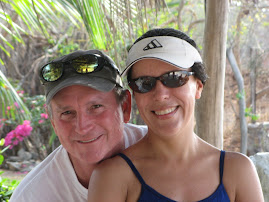
August 3, 2008
Dawson City did not exist until 1896 when gold was discovered nearby. This sparked the Klondike Gold Rush of 1897-8. In August 1896 a prospector found a flake of gold in Rabbit Creek (this drained into the Klondike River that drained into the large Yukon River). Three hunters in the area ran in to him about the time it happened but didn't seem too interested, they thought gold prospecting was a waste of time. A month later the three hunters found a large nugget in a creek and were soon struck with Gold Fever. They staked their claims and the other independent prospectors in the area followed suit.
Original building sinking due to permafrost (ground underneath) melting.
Tour guide in Red Feather Saloon, this is identical replica.
The area where the gold was found is so isolated and locked in due to the severe winter weather the news of what was to be the biggest gold find in history did not get out to the rest of the world until May 1897. Boats that delivered the gold with their rightful owners to the ports in Portland and Seattle were met with masses of people wanting to see the lode. The Klondike Gold Rush was on!
Below is original mortuary, ppl that died in the winter were kept on ice until spring thaw.

One hundred thousand people dreamed and took action to go to the Klondike area and dig for gold. Most of them traveled up the Inside Passage to Skagway, then hiked 109 miles to Whitehorse (this hike is a book within itself), then made their boats and floated down the Yukon River to Dawson City (~400 miles by river): the rapidly made city popped up where the Klondike and Yukon rivers met. By the time they arrived, June 1898 (almost 2 years after gold was found), all the claims were staked. As you can imagine, 50000 made it to Dawson, 7000 made it to the fields and a handfull made it rich.
Dawson City an out-of-the-way place to visit to learn every nuance about the Klondike Gold Rush, from the pan sifting miner to larger corporate mining, as well as the First Nations peoples that lived in the area. This city seems to mainly be supported by tourism and residual mining. Canada Parks offers a variety of tours throughout a day and the city is maintained (best they can) in the flavor of what this gold rush city was like in the late 19th century. Lots of room to roam and no crowds.
We took a city tour given by an enthusiastic young lady, Jill. Then sat for a 10 minute one woman show of a character of one of the Klondikers. In the early afternoon we went to Dredge #4, this was an eye-opener. The tour guide, Sue, was intense, enthusiastic and deeply knowledgeable about all types of mining. She could spout out material type, values, densities, geography, and water pressure usage necessary for every step of mining. She could not be stumped! Afterwards, we went to the Keno, a steamship paddler that once used to travel along the Yukon River again given by Jill. The Canada Parks system does an outstanding job preserving this part of Canadian history. We had signed up for the 3 tour package ($13.60/pp)and it took all day with 1-1.5 hour breaks between. We were too pooped to do all the tours! One could easily spend two days here.
 Dredges are enormous efficient mining machines that churn up riverbeds extracting gold. Right Bruce inside Dredge #4, below Bruce is standing on outside.
Dredges are enormous efficient mining machines that churn up riverbeds extracting gold. Right Bruce inside Dredge #4, below Bruce is standing on outside.
I have only told a snipet of the history of the Klondike Gold Rush. By the end of the day I was supersaturated with information and my brain was full. We sat at our campsite along the Yukon and wondered what it was like to live before the rush came and how difficult the winters must be with the river frozen over.




2 comments:
Pat and Bruce
That last photo is really spectacular. Have you seen the BUMS yet? I believe they are up and around your area. Be sure to tell them that the Yorks say Hello! I will forward my last email from them to you.
great write up woman. I know how much you love that kind of history. Glad you and bruce found a place away from the crowds. :)
Post a Comment